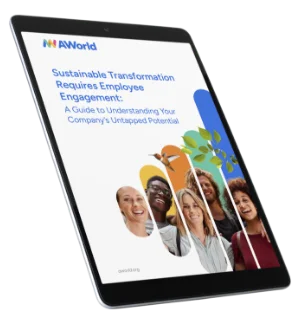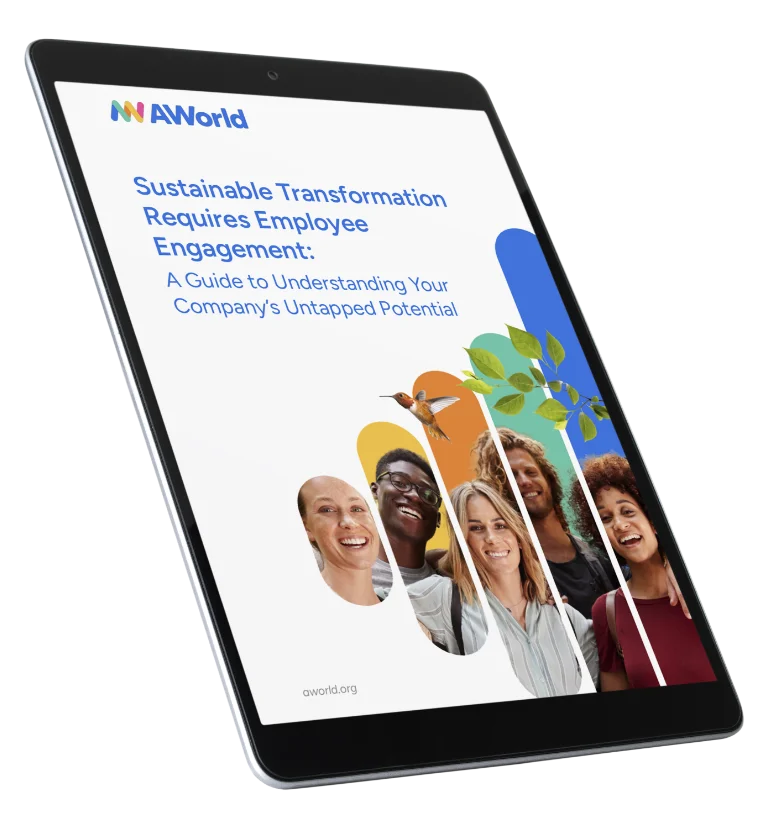For businesses, sustainability is no longer just an option, but a necessity.
And at the heart of the transition towards a more sustainable business strategy lies the concept of stakeholder engagement, an activity that no forward-thinking company can afford to overlook.
In this article, we will delve into the core of stakeholder engagement in sustainability, examining its role and understanding how to effectively involve them in a company’s sustainability journey.
Table of Contents
- What is stakeholder engagement in sustainability?
- Why is it important?
- What is the role of stakeholders in improving sustainability?
- How to map and prioritize stakeholders?
- How to engage stakeholders in sustainability projects?
- How to communicate sustainability goals to stakeholders?
- How to measure stakeholder impact on ESG metrics?
- Challenges and obstacles in stakeholder engagement
- AWorld: facilitating effective stakeholder engagement
What is stakeholder engagement in sustainability?
Stakeholder engagement goes well beyond maintaining a dialogue: it involves integrating diverse perspectives into the very fabric of a company’s sustainability strategy. This involvement is especially crucial today, in an era where environmental and social impacts are considered as important as financial returns.
Stakeholder engagement is a strategic process through which companies seek to involve key groups and individuals who have or can have a significant impact on the environmental, social and governance (ESG) practices of a company. This process transcends the traditional boundaries of the business world, extending to community, environment and society at large. In other words, it’s about identifying and understanding stakeholders – ranging from local communities, customers, employees, suppliers, governmental bodies, investors, to NGOs – and recognizing their interests, concerns and expectations.
Why is it important?
The importance of stakeholder engagement in sustainability lies in the wealth of insights and perspectives these stakeholders can provide. Indeed, stakeholders can help companies anticipate and mitigate risks associated with their sustainability activities and initiatives. For example, local communities can provide on-the-ground information about environmental impacts, and investors can offer perspectives on long-term financial sustainability and risk management.
Furthermore, stakeholder engagement is essential for creating a sense of trust and transparency. Companies that engage effectively with their stakeholders tend to have a better reputation, increased customer loyalty and greater investor confidence.
But it doesn’t stop there: effective stakeholder engagement also includes collaboration and co-creation. It involves working together with stakeholders to identify sustainability priorities, develop strategies and implement initiatives. This collaborative approach ensures that sustainability strategies are robust, relevant and capable of achieving real impact.
What is the role of stakeholders in improving sustainability?
Stakeholders are not merely passive observers, but should be active participants in a company’s sustainability strategy, offering unique contributions at various levels of the process:
- Innovators and idea generators: stakeholders can be a source of innovative ideas. Employees, for example, can provide valuable insights for operational improvements that reduce waste or increase efficiency, leveraging their on-the-ground experience. Customers and end-users can offer feedback on products and services, pushing the company towards more sustainable options. Suppliers, on the other hand, play a crucial role in introducing sustainable materials and practices into the supply chain.
- Reality checkers: they help verify the sustainability of initiatives. For instance, community groups and NGOs, with their knowledge and field experience, can offer valuable perspectives on the social impact of corporate actions.
- Brand advocates: when stakeholders are genuinely involved and believe in a company’s sustainability efforts, they can become powerful brand ambassadors. Satisfied customers and employees who feel their values align with the company’s actions are more likely to share their positive experiences, enhancing the company’s reputation and brand value.
- Feedback providers: they provide feedback that helps companies refine their sustainability strategies. This can come through channels such as surveys and meetings, or through social media and direct communications.
- Financial and strategic supporters: investors and shareholders provide the financial backing and strategic direction needed for long-term sustainability projects. For instance, their growing focus on ESG (Environmental, Social, and Governance) factors has been a significant driver in pushing companies towards more sustainable practices.
- Implementation partners: finally, stakeholders are often partners to rely on in the actual implementation of sustainability initiatives. This can range from employee participation in corporate sustainability programs to partnerships with external organizations.
How to map and prioritize stakeholders?
Defining and prioritizing which stakeholders to focus on is a crucial phase in stakeholder engagement. This process involves more than just listing people and institutions interested in or influencing the company’s activities; it’s a necessary strategy to understand the stakeholder ecosystem and strategically align it with the company’s sustainability objectives.
- Stakeholder identification: the first step is, of course, the complete identification of stakeholders, ranging from internal stakeholders like employees and management, to external ones such as suppliers, customers, local communities, regulatory authorities, and investors. Each of these groups has different interests, levels of influence, and interactions with the company.
- Stakeholder analysis: once identified, the next step is to analyze the power, legitimacy, and urgency of stakeholders. Power refers to the stakeholder’s ability to influence the company’s decisions or operations; legitimacy concerns the appropriateness of their involvement based on legal, moral, or social norms; urgency refers to the degree and speed with which the stakeholder’s requests or concerns need to be addressed.
- Understanding stakeholders’ expectations and interests: it’s crucial to understand what each stakeholder group expects from the company in terms of sustainability and how these expectations align with the company’s objectives. This phase involves engaging with stakeholders to grasp their viewpoints, concerns, and aspirations.
- Prioritizing stakeholders: in this phase, stakeholders are categorized based on their influence and interest in the company’s sustainability initiatives. This is where companies decide which are the key stakeholders that require immediate attention and which can be engaged more periodically. Prioritization is dynamic and can change over time, as the company’s sustainability journey evolves and the interests and levels of influence of stakeholders shift.
How to engage stakeholders in sustainability projects?
Engaging stakeholders in sustainability projects involves more than just consulting them; it requires actively collaborating with them in a co-creation process.
- Understanding stakeholders’ perspectives
The first step in engaging stakeholders is to understand their perspectives, concerns, and expectations. The goal is to gather opinions and identify common themes and concerns that need to be addressed in sustainability projects.
- Co-creation and planning
Once stakeholders’ perspectives are understood, the next step is to involve them in the planning process of initiatives. This can involve creating teams or holding brainstorming sessions with stakeholders.
- Regular communication and engagement
Effective stakeholder engagement requires ongoing communication and regular updates on the project’s progress, challenges faced, and milestones achieved. It’s also important to maintain a two-way communication channel where stakeholders can provide continuous feedback and suggestions.
- Empowering stakeholders
Empowerment is a key element of stakeholder engagement. Providing stakeholders with the resources, information, and authority to make decisions can significantly enhance their involvement and commitment to the project.
- Monitoring and feedback
Establishing mechanisms to monitor the impact of stakeholder engagement and gather feedback on the process is crucial. It’s important for stakeholders to see tangible results of their involvement, as this reinforces their sense of belonging and commitment to the project.
How to communicate sustainability goals to stakeholders?
Effectively communicating and making sustainability objectives clear to stakeholders is an essential component for their active involvement. Achieving this goal requires a strategy focused on clarity, transparency and consistency. It involves a complex process of aligning the company’s sustainability ambitions with the diverse values and expectations of its stakeholders.
This communication requires the use of a variety of different channels, from reports to social media, from interactive platforms to direct meetings. Through these channels, the aim is to maintain a constant flow of communication that not only keeps stakeholders well-informed, but also actively involved and continuously inspired by the sustainability journey.
How to measure stakeholder impact on ESG metrics?
Measuring the impact of stakeholder engagement on Environmental, Social, and Governance (ESG) metrics is a complex process. Firstly, companies need to establish clear and quantifiable ESG objectives that align with their sustainability goals and the expectations of stakeholders. These objectives can encompass a wide range of metrics, from environmental factors like carbon emissions and energy efficiency to social and governance aspects such as employee well-being and supply chain practices.
Once this is done, it’s necessary to analyze feedback provided by stakeholders to assess their influence on sustainability initiatives. Regular review and adjustment of these metrics are crucial, as sustainability needs and stakeholder requirements are continuously evolving. Moreover, communicating these results back to stakeholders is essential to maintain transparency and trust, demonstrating that their contribution has a tangible impact on the company’s sustainability efforts. Overall, this measurement is a fundamental part of a comprehensive sustainability strategy, helping to ensure the effectiveness of stakeholder engagement and guiding future improvement actions.
Challenges and obstacles in stakeholder engagement
Engaging stakeholders in sustainability initiatives is an undertaking that can often be challenging. Companies embarking on this journey must navigate a maze of potential obstacles and challenges. These include:
- Diverse interests and expectations: one of the main challenges is the diversity of the stakeholders themselves. Each group – whether customers, employees, suppliers, community members, or investors – has different interests, expectations and priorities. Aligning these diverse viewpoints with a company’s sustainability goals can lead to a delicate balancing act. Often, it’s necessary to negotiate and reconcile conflicting interests to find common ground.
- Communication barriers: effective communication is crucial for stakeholder engagement but represents a significant challenge. The complexity arises not only from the diversity of stakeholders but also from the variety of communication channels and messages. Ensuring clear, consistent and transparent communication to each stakeholder group requires a tailored approach.
- Building and maintaining trust: gaining and maintaining stakeholders’ trust can be challenging. This trust is built over time through transparent communication and building trust. Any misstep in sustainability initiatives or in a company’s stakeholder engagement practices can quickly erode these hard-earned relationships.
- Long-term engagement and involvement: lastly, sustaining stakeholders’ engagement over the long term can require significant efforts. Companies need to continuously seek to re-engage stakeholders, update them on progress and involve them in new initiatives, which can demand considerable resource expenditure.
AWorld: facilitating effective stakeholder engagement
In this complex landscape, AWorld stands out as an extremely effective tool for enhancing stakeholder engagement in sustainability. The platform offers numerous features that facilitate communication, planning, monitoring progress and reporting, making the stakeholder engagement process more efficient, transparent and impactful. AWorld acts as a bridge, connecting companies with their stakeholders in a meaningful way, ensuring that sustainability efforts are not just corporate endeavors, but collaborative journeys towards a better future.
In essence, stakeholder engagement in sustainability is more than a business strategy; it’s a collaborative journey towards a more sustainable and equitable world. By deeply understanding, actively involving and effectively communicating with stakeholders, companies can not only achieve their sustainability goals but also promote a culture of shared responsibility and collective action. Platforms like AWorld are crucial in this journey, as they provide the necessary tools and framework for effective engagement of all stakeholders.






